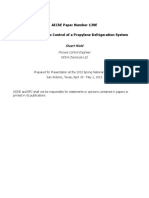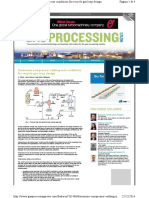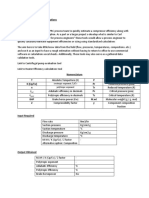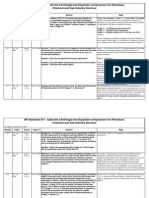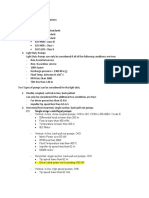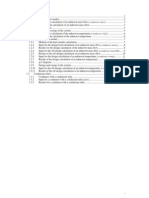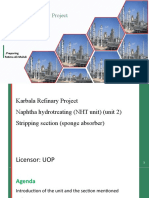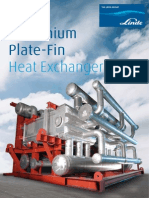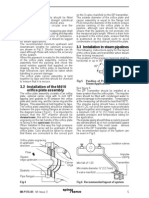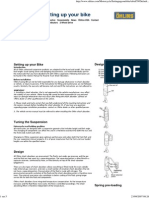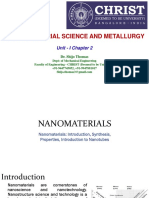Compressor
Compressor
Uploaded by
soxalCopyright:
Available Formats
Compressor
Compressor
Uploaded by
soxalOriginal Description:
Copyright
Available Formats
Share this document
Did you find this document useful?
Is this content inappropriate?
Copyright:
Available Formats
Compressor
Compressor
Uploaded by
soxalCopyright:
Available Formats
GUIDE DOCUMENT
PROCESS ENGINEERING DESIGN GUIDE
PART 1 SECTION 1
PROCESS MANUAL (DATA BOOK)
GE
Issued
Book N
Chapter N
Rev.
Page
312
1.1.2.
VII
2/27
S.S. 1.2 : Process Equipment
CHAPTER VII Compressors
CONTENTS
1.
GENERAL
1.1
1.2
2.
TYPES OF COMPRESSORS
2.1
2.2
2.3
3.
Selection chart
Performance curves
Main features of compressors
CALCULATION OF ADIABATIC EXPONENT K=Cpo/Cvo
3.1
3.2
4.
Theoretical reminders - Mollier diagram
Methods of calculation - Units
Estimation from charts
Detailed calculation
CENTRIFUGAL COMPRESSORS
4.1
4.2
Estimation from chart
Detailed calculation
4.2.1
4.2.2
4.2.3
4.2.4
4.2.5
4.2.6
4.2.7
4.2.8
5.
AXIAL COMPRESSORS
5.1
5.2
5.3
GE 1 - ANG - rev. 0
Polytropic efficiency
Polytropic Head (Hp)
Shaft Power
Discharge temperature
Number of wheels / casings required
Intake flow
Speed variation
Sample calculation
Polytropic efficiency
Suction flow
Maximum pressure
GUIDE DOCUMENT
PROCESS ENGINEERING DESIGN GUIDE
PART 1 SECTION 1
PROCESS MANUAL (DATA BOOK)
6.
GE
Issued
Book N
Chapter N
Rev.
Page
312
1.1.2.
VII
3/27
S.S. 1.2 : Process Equipment
CHAPTER VII Compressors
RECIPROCATING COMPRESSORS
6.1
6.2
Estimation from chart
Performance calculation
6.2.1
6.2.2
6.2.3
6.2.4
Number of stages and discharge temperature
Adiabatic power
Total shaft power
Sample calculation
7.
BLOWERS
8.
INSTRUMENT AND SERVICE AIR COMPRESSORS
GE 1 - ANG - rev. 0
GE
GUIDE DOCUMENT
PROCESS ENGINEERING DESIGN GUIDE
PART 1 SECTION 1
PROCESS MANUAL (DATA BOOK)
1.
Issued
Book N
Chapter N
Rev.
Page
312
1.1.2.
VII
4/27
S.S. 1.2 : Process Equipment
CHAPTER VII Compressors
GENERAL
1.1.
a.
Theoretical reminders Mollier Diagram
Adiabatic and polytropic compression
Compression of an ideal gas can be considered as adiabatic (PVk = constant and k=Cp/Cv) or
polytropic (PVn = constant).
Compressor manufacturers generally use the adiabatic compression model for reciprocating
compressors and the polytropic compression model for centrifugal or axial compressors. Adiabatic
or polytropic efficiencies are applied in the calculation to account for true behaviour.
The conversion of adiabatic efficiency ad to polytropic efficiency p for a given compression
service (compression ratio and k=Cp/Cv are known), may be obtained from Figure 1 below.
FIGURE 1 - GPSA SI 5.8 1980
GE 1 - ANG - rev. 0
GE
GUIDE DOCUMENT
PROCESS ENGINEERING DESIGN GUIDE
PART 1 SECTION 1
PROCESS MANUAL (DATA BOOK)
b.
Issued
Book N
Chapter N
Rev.
Page
312
1.1.2.
VII
5/27
S.S. 1.2 : Process Equipment
CHAPTER VII Compressors
Mollier diagram
Whenever a Mollier diagram is available for the gas to be compressed, the following simple
calculation method may be used.
FIGURE 2 - Simplified Mollier Diagram
From Inlet state point 1 at intersection of p1 and t1 (suction conditions), follow line of
constant entropy to discharge pressure p2, locating adiabatic discharge state point 2ad.
The adiabatic head Had is : Had (N.m / kg) = had (kJ / kg) x 1000 with had = h2ad-h1
(in British units : conversion factor = 778 ft.Lb / Btu with enthalpy in Btu / Lb)
Using an estimated adiabatic efficiency had (refer to following sections), the actual
discharge enthalpy h2 is :
h ad
+ h1
h2 =
ad
On Mollier, plot vertically from h2 to p 2, locate discharge state point 2 and read t 2.
The shaft power is :
Pu ( kW ) =
GE 1 - ANG - rev. 0
W1 ( kg / h ) x H ad ( N.m / kg )
ad x 36 x 10 5 (J / kW.h )
H ad x p
ad
See efficiency conversion chart on Figure 1.
(Note : 1 kJ/kg = 2.326 Btu/Lb)
The polytropic head is :
hp =
GUIDE DOCUMENT
PROCESS ENGINEERING DESIGN GUIDE
PART 1 SECTION 1
PROCESS MANUAL (DATA BOOK)
1.2.
GE
Issued
Book N
Chapter N
Rev.
Page
312
1.1.2.
VII
6/27
S.S. 1.2 : Process Equipment
CHAPTER VII Compressors
Methods of calculation - Units
In the following sections, two calculation methods are described :
A quick power estimate from charts.
A more accurate method based on simple calculation for power and discharge temperature.
The System International (SI) of units is generally used throughout the calculation. Usual units
may be used instead (e.g. pressure in bar instead of kPa).
2.
TYPES OF COMPRESSORS
2.1.
Selection chart
The following chart gives typical fields of application for various types of compressors. Note
that actual limits may vary from one manufacturer to another. Consider this chart as a guideline
only for the most common applications.
GE 1 - ANG - rev. 0
GUIDE DOCUMENT
PROCESS ENGINEERING DESIGN GUIDE
PART 1 SECTION 1
PROCESS MANUAL (DATA BOOK)
2.2.
GE
Issued
Book N
Chapter N
Rev.
Page
312
1.1.2.
VII
7/27
S.S. 1.2 : Process Equipment
CHAPTER VII Compressors
Performance curves
The performance curves (polytropic head vs. suction volumetric flow) are different for each
type of compressor.
Al :
Ax :
C:
Reciprocating
Axial
Centrifugal
FIGURE 4
GE 1 - ANG - rev. 0
GUIDE DOCUMENT
PROCESS ENGINEERING DESIGN GUIDE
PART 1 SECTION 1
PROCESS MANUAL (DATA BOOK)
2.3.
GE
Issued
Book N
Chapter N
Rev.
Page
312
1.1.2.
VII
8/27
S.S. 1.2 : Process Equipment
CHAPTER VII Compressors
Main features of compressors
Type
TABLE 1
Speed
Capacity
Compression ratio
Centrifugal
3000 to 30000 rpm
Suction flow :
- Min. : 400 m3 / h
- Max. : 2 x 170000 m3 / h
Compression
Efficiency
50 to 80 %
Typically : 75%
Polytropic head (Hp) :
1500 m to 30000 m / casing
Axial
3000 to 12000 rpm
Reciprocating
Screw
) -Steam turbine
) -Gas turbine
) -Electrical motor
) -Turbo-Expander
2) Surge occurring at about 40 to )
85% of nominal flow, depending )
)
on gas and compression ratio
)
)
1) Compression ratio is affected
by changes in gas properties
(specific gravity, MW)
All pressures
All fluids
-Catalytic cracking
-Reforming H2 recycle
-Refrigerant cycles
-Natural gas
-Syngas
-Air
75-85%
1) Recommended for intermittent 1) Spare is required for critical
operation
services due to limited continuous operation period
2) Economical for low capacities
2) Higher maintenance cost than
3) Up to 3500 bar discharge pres- centrifugal
sure
3) Piping layout to be carefully
4) Higher efficiency than centrifu- designed because of vibrations
gal for low power
4) Non lubricated machines
5) Not affected by gas properties require frequent overhauls
)
)
)
)
) Electrical motor
) Gas motor
)
)
)
)
)
)
-Instrument air
-Plant air
-Fuel gas
-Syngas
-Reforming (small capacity)
-Low MW gases
-Natural gas
-Refrigerant cycles
75-80%
1) Lower cost than centrifugal
1) Silencers required at suction /
discharge
)
)
)
)
)
) -Electrical motor
)
)
)
)
)
)
)
-Plant air
-Fuel gas
-Small cat. cracking air
compressors
-Packaged refrigerant
cycles
1) Limited flexibility and continuous operation unless adjus2) Very reduced dimensions for a table guide vanes are used
given capacity
2) Performance and efficiency
3) Higher efficiency than centrifu- are reduced in case of fouling
gal
1) Very high capacity
2) Higher efficiency than centrifu2) Affected by temperature
gal
increase
3) Not affected by gas properties
3) Not recommended for heavy
fouling
4) Standardized parts
4) Flow control by either variable
speed or bypass
5) P limited
GE 1 - ANG - rev. 0
Typical
applications
4) Parallel operation satisfactory
Compression ratio :
Max : 4.5 per stage, or max.
discharge temperature at
160-1900C
Compression ratio :
2 to 7 per casing but for a
max. P of 15 bar.
3) Reduced dimensions for a
given capacity
Driver type
-Large air compressor
(cat. cracking, blast
furnace)
Suction flow :
0 to 1300 m3 / h
Suction flow :
500 to 4 000 m3 / h
2) Low maintenance costs
Disadvantages
)
)
)
) Steam turbine
) Gas turbine
) Electrical motor
)
)
)
75-85%
Compression ratio :
2 to 6 per casing
1 500 to 10 000 rpm
1) Continuous operation is
possible during long periods
4) Flow control is easy
Suction flow :
Min : 50000 m3 / h
300 to 1500 rpm
Advantages
-Liquefaction cycles
-Pressure limited to 30 bar
GUIDE DOCUMENT
PROCESS ENGINEERING DESIGN GUIDE
PART 1 SECTION 1
PROCESS MANUAL (DATA BOOK)
3.
GE
Issued
Book N
Chapter N
Rev.
Page
312
1.1.2.
VII
9/27
S.S. 1.2 : Process Equipment
CHAPTER VII Compressors
CALCULATION OF ADIABATIC EXPONENT K
The adiabatic exponent k that is used in formula is, by convention, taken as Cp0/Cv0 (Cp/Cv of
ideal-gas state) at suction temperature.
3.1.
Estimation from charts
If only the molecular weight of the gas is known (hydrocarbon mixtures), and not its
composition, an approximate value for k can be determined from the curve given in Chapter
VI - S.S. 1.1 of the Process Data Book (see GPSA Fig. 13.8).
3.2.
Detailed calculation
For a more accurate calculation, and for non-hydrocarbon gases, k is calculated using the
following equation which applies to all ideal gases :
k=
Cpo
Cvo
M x Cpo
M x Cpo R
Where :
MCp0
Constant pressure molar specific heat capacity (ideal-gas state)
Universal gas constant
= 8.3145 if MCp0 is in kJ / kmol.C
= 1.986 if MCp0 is in kcal / kmol.C or Btu / Lbmol.F
Table 2 below gives the values of MCp0 for various gases. For multi-component gas, the mole
weighted average value of molar heat capacity must be determined. See the sample calculation
below.
GE 1 - ANG - rev. 0
Issued
Book N
Chapter N
Rev.
Page
312
1.1.2.
VII
10/27
GE
GUIDE DOCUMENT
PROCESS ENGINEERING DESIGN GUIDE
PART 1 SECTION 1
PROCESS MANUAL (DATA BOOK)
S.S. 1.2 : Process Equipment
CHAPTER VII Compressors
TABLE 2
REFERENCE GPSA SI 4.1 EDITION 1980
Example : Gas at 75 C intake temperature
TABLE 3 - Calculation of k
Example gas mixture
Component
name
Mole
fraction y
Determination of equivalent
molecular mass
Individual component
yxM
molecular mass M
Determination of MCp
Molar specific heat capacity
y x MCp
Individual component MCp
at 75oC
at 75 oC
Methane
Ethane
Propane
i-Butane
n-Butane
i-Pentane
0.9216
0.0488
0.0185
0.0039
0.0055
0.0017
16.04
30.07
44.10
58.12
58.12
72.15
14.782
1.467
0.816
0.227
0.320
0.123
37.870
58.819
83.585
110.408
110.334
135.581
34.901
2.870
1.546
0.431
0.607
0.230
Total
1.0000
M mix
17.735
MCp mix
40.585
k = MCp/MCv
k = 40.585 / (40.585 - 8.3145) = 1.26
Note - Other sources : refer to Chapter VI, S.S 1.1. of the Process Data book.
GE 1 - ANG - rev. 0
GUIDE DOCUMENT
PROCESS ENGINEERING DESIGN GUIDE
PART 1 SECTION 1
PROCESS MANUAL (DATA BOOK)
4.
GE
Issued
Book N
Chapter N
Rev.
Page
312
1.1.2.
VII
11/27
S.S. 1.2 : Process Equipment
CHAPTER VII Compressors
CENTRIFUGAL COMPRESSORS
4.1.
Estimation from chart
Curves are available which allow easy estimation of horsepower requirement for a given k
value (1.4 in the example below), compression ratio, suction pressure, and suction volumetric
flow.
FIGURE 5
Doc. NUOVO PIGNONE
GE 1 - ANG - rev. 0
GUIDE DOCUMENT
PROCESS ENGINEERING DESIGN GUIDE
PART 1 SECTION 1
PROCESS MANUAL (DATA BOOK)
4.2.
GE
Issued
Book N
Chapter N
Rev.
Page
312
1.1.2.
VII
12/27
S.S. 1.2 : Process Equipment
CHAPTER VII Compressors
Detailed calculation
4.2.1. Polytropic efficiency
a.
For single wheel
FIGURE 6
This curve is derived from the following equations :
GE 1 - ANG - rev. 0
Qv > 8 500 m3 / h (approximately 5 000 ACFM)
p = 0.751 + 0.01985 Ln (Qv / 8500)
Qv < 8 500 m3 / h
p = 0.751 + 0.01985 Ln (Qv / 8500) - 0.02 [ Ln (Qv / 8 500) ]2
GUIDE DOCUMENT
PROCESS ENGINEERING DESIGN GUIDE
PART 1 SECTION 1
PROCESS MANUAL (DATA BOOK)
b.
GE
Issued
Book N
Chapter N
Rev.
Page
312
1.1.2.
VII
13/27
S.S. 1.2 : Process Equipment
CHAPTER VII Compressors
For multiple-wheel stage
Provided that there is no intermediate intake, the polytropic efficiency calculated at stage
suction shall apply to the complete stage. This usually leads to a reasonable accuracy.
In the case of lateral intake, depending on the intake volume flow rate compared to compressed
gas volume flow rate, efficiency may need to be reviewed.
4.2.2. Polytropic head (Hp)
Z m R Ta p k Pr
Hp =
x
k 1 Pa
M
k 1
k p
Where :
Hp in kJ / kg or kN.m / kg
k
M
Pr, P a
R
Zm
p
Ta
: Adiabatic exponent = Cp0/Cv0, calculated in Section 3.2,
: Gas molecular weight,
: Discharge and suction absolute pressures,
: Universal gas law constant = 8.314 kJ / kmol.K,
: Average compressibility,
: Polytropic efficiency, calculated in section 4.2.1,
: Suction temperature, K
Hp is often expressed in metre or feet by analogy with pump differential head
1 kJ/kg = 1 kN.m/kg = 101.97 kgf.m/kg, i.e. 101.97 "metres" or 334.4 "feet" (that is,
approximately, 30 kJ/kg = 10 000 feet)
Reminder
For a given compressor (rotation speed and wheel diameter fixed), a variation in the gas
properties or in suction conditions will change the compression ratio t = Pr / Pa while the
polytropic head is not affected.
GE 1 - ANG - rev. 0
GUIDE DOCUMENT
PROCESS ENGINEERING DESIGN GUIDE
PART 1 SECTION 1
PROCESS MANUAL (DATA BOOK)
Issued
Book N
Chapter N
Rev.
Page
312
1.1.2.
VII
14/27
GE
S.S. 1.2 : Process Equipment
CHAPTER VII Compressors
4.2.3. Shaft power
The gas horsepower is :
Z m R Ta
Q
k Pr
Pu =
x
x
3 600
M
k 1 Pa
Where :
Pu
Hp
k
M
Pr, P a
R
Q
Zm
p
Ta
k 1
k p
: Gas Horsepower in kW,
: Polytropic head kJ / kg,
: Adiabatic exponent k = Cp0 / C v0,
: Gas molecular weight,
: Discharge and suction absolute pressure,
: Universal gas law constant = 8.314 kJ / kmol.K,
: Mass flow, kg / h,
: Average compressibility,
: Polytropic efficiency (see Section 4.2.1),
: Suction temperature, K.
P (shaft horsepower) = Pu (gas horsepower) + bearing and oil seal losses
Losses are taken as 40 kW as a first approach (80 kW for Pu > 8 000 kW)
Note - In case a mechanical speed variator is installed, consider 2.5% of the compressor power
as additional losses.
4.2.4. Discharge temperature
GE 1 - ANG - rev. 0
P
Tr = Ta r
Pa
Where :
k 1
k p
Tr
Ta
Pr, P a
p
: Discharge temperature, K.
: Suction temperature, K.
: Discharge and suction absolute pressure,
: Polytropic efficiency (see Section 4.2.1).
GE
GUIDE DOCUMENT
PROCESS ENGINEERING DESIGN GUIDE
PART 1 SECTION 1
PROCESS MANUAL (DATA BOOK)
Issued
Book N
Chapter N
Rev.
Page
312
1.1.2.
VII
15/27
S.S. 1.2 : Process Equipment
CHAPTER VII Compressors
4.2.5. Number of wheels
The following guidelines may be followed :
The maximum polytropic head for a single wheel is in the range of 10 000 to 12 000 feet
(10 000 feet corresponds to about 30 KJ / Kg).
A casing may contain up to 8 wheels (or even 10, if they are small), with the following
guidelines :
Intercooling (one inlet and one outlet) will necessitate removal of 1 wheel, i.e. the
casing can only contain 8-1 = 7 wheels.
The presence of a side stream (inlet or outlet) does not modify the maximum number of
wheels.
The approximate minimum number of wheels required for a given polytropic head and gas
molecular weight can be determined using the following chart :
FIGURE 7
GPSA SI 1980
GE 1 - ANG - rev. 0
GE
GUIDE DOCUMENT
PROCESS ENGINEERING DESIGN GUIDE
PART 1 SECTION 1
PROCESS MANUAL (DATA BOOK)
Issued
Book N
Chapter N
Rev.
Page
312
1.1.2.
VII
16/27
S.S. 1.2 : Process Equipment
CHAPTER VII Compressors
4.2.6. Intake flow
For a centrifugal compressor, the maximum volume flow at suction conditions is
approximately 170 000 actual m3/h (i.e. ~100 000 ACFM).
Should the flow become close from this value, a split flow compressor may be required.
Suction flow
(real)
m3/h
Number of wheels
per casing
Speed for Hp
of 30 kJ/kg
rpm
Notes
Q < 800
800 - 12 000
12 000- 34 000
34 000- 56 000
56 000- 94 000
94 000- 136 000
136 000- 195 000
195 000- 245 000
245 000 - 340 000
10
9
9
8
8
8
7
7
up to 20 000
10 500
8 200
6 500
4 900
4 300
3 600
2 800
2 500
Special compressor
Source : Catalogues from manufacturers and GPSA 1980.
4.2.7. Speed variation
Q1 N1
=
Q2 N 2
H1 N1
=
H 2 N 2
Where :
N:
Q:
H:
Pu :
GE 1 - ANG - rev. 0
Speed, in rpm,
Volume flow,
Polytropic head,
Absorbed power.
Pu 1 N1
=
Pu 2 N 2
Simple or split flow
Split flow
Split flow
GE
GUIDE DOCUMENT
PROCESS ENGINEERING DESIGN GUIDE
PART 1 SECTION 1
PROCESS MANUAL (DATA BOOK)
Issued
Book N
Chapter N
Rev.
Page
312
1.1.2.
VII
17/27
S.S. 1.2 : Process Equipment
CHAPTER VII Compressors
4.2.8. Sample calculation
Compression of hydrocarbon gas with a molecular weight of 22.03, from 26.5 bar a and -35C
to 43.59 bar a
Molar flow
: 5 891.7 kmol / h
Estimated compressibility factor
: z = 0.786.
a.
Suction volume flow
(PV = nzRT)
273.16 35
x 5891.7 10 3
Q = 0.786 x 8.314 x
26.5 10 5
Q = 3.46 x 103 m3 / h
Type of compressor : centrifugal (vertically-split casing arrangement), or reciprocating (see chart
in Section 2.1).
b.
k calculation
From section 3.1, with MW = 22.03 and T = -35 C, k = 1.28
(Calculation from section 3.2 for a known composition).
c.
Polytropic efficiency
From Section 4.2.1 , with Q = 3.46 x 103 m3 / h ;
d.
Hp =
Polytropic head
0.786 x 8 314 x (273.16 35) 0.716 x 1.28
x
22.03
1.28 1
1.28 1
43.59 1.28 x 0.716
26.5
Hp = 37.97 kJ / kg that is 37.97 x 101.94 = 3 871 m
Number of wheels : probably 2
GE 1 - ANG - rev. 0
p = 0.716
GUIDE DOCUMENT
PROCESS ENGINEERING DESIGN GUIDE
PART 1 SECTION 1
PROCESS MANUAL (DATA BOOK)
e.
Pu =
f.
GE
Issued
Book N
Chapter N
Rev.
Page
312
1.1.2.
VII
18/27
S.S. 1.2 : Process Equipment
CHAPTER VII Compressors
Power
5891.7 x 22.03
x 37.97 = 1912 kW
3600 x 0.716
(1700 kW from chart in Section 4.1)
Discharge temperature
Tr = (273.16 - 35) x
1.28 1
43.59 1.28 x 0.716
26.5
Tr= 4.1C
5.
AXIAL COMPRESSORS
The calculation is identical to that of centrifugal compressors, with the following exceptions.
5.1.
Polytropic efficiency
Polytropic efficiency is higher than for centrifugal compressors.
Typical value for calculation : p = 80 to 85%.
5.2.
Suction flow
This type of compressor requires a minimum suction volume flow of about 50 000 m3/h to
perform satisfactorily.
5.3.
Maximum pressure
Discharge pressure is limited to ~ 30 bar a.
GE 1 - ANG - rev. 0
GUIDE DOCUMENT
PROCESS ENGINEERING DESIGN GUIDE
PART 1 SECTION 1
PROCESS MANUAL (DATA BOOK)
6.
GE
Issued
Book N
Chapter N
Rev.
Page
312
1.1.2.
VII
19/27
S.S. 1.2 : Process Equipment
CHAPTER VII Compressors
RECIPROCATING COMPRESSORS
6.1.
Estimation from chart
From the k value calculated in Section 3, the following curve allows an easy estimation of
compression horsepower requirements.
FIGURE 8 - Estimation of compression horsepower for reciprocating compressors
(from CREUSOT-LOIRE)
GE 1 - ANG - rev. 0
GUIDE DOCUMENT
PROCESS ENGINEERING DESIGN GUIDE
PART 1 SECTION 1
PROCESS MANUAL (DATA BOOK)
6.2.
GE
Issued
Book N
Chapter N
Rev.
Page
312
1.1.2.
VII
20/27
S.S. 1.2 : Process Equipment
CHAPTER VII Compressors
Performance calculation
6.2.1. Number of stages and discharge temperature
The number of stages is estimated based on the following two criteria :
a.
The discharge temperature of each stage shall not exceed 180C. For dry piston
compressors with Teflon segments, the discharge operating temperature shall be limited to
135 / 140C.
The discharge temperature is calculated by :
k 1
Pr k
Tr = Ta x
Pa
Tr, T a
Pr, P a
k
: Discharge and suction temperatures, K
: Discharge and suction absolute pressures,
: Adiabatic exponent, calculated in Section 3.
Note - This temperature is the ideal adiabatic compression temperature, not to be
confused with the discharge temperature of centrifugal compressors (refer to
Section 4.2.4).
It does not take into account frictional losses and the non-reversibility of compression
process. The actual discharge temperature will be calculated by the compressor
manufacturer. The temperature increase (Tr - Ta) will usually raise by 10 to 15%.
The theoretical discharge temperature given in Figure 9 is derived from this equation.
b.
GE 1 - ANG - rev. 0
The total compression ratio is obtained by multiplying the stage-wise compression ratios,
taking into account pressure drop through intercoolers.
GUIDE DOCUMENT
PROCESS ENGINEERING DESIGN GUIDE
PART 1 SECTION 1
PROCESS MANUAL (DATA BOOK)
GE 1 - ANG - rev. 0
GE
Issued
Book N
Chapter N
Rev.
Page
312
1.1.2.
VII
21/27
S.S. 1.2 : Process Equipment
CHAPTER VII Compressors
GUIDE DOCUMENT
PROCESS ENGINEERING DESIGN GUIDE
PART 1 SECTION 1
PROCESS MANUAL (DATA BOOK)
GE
Issued
Book N
Chapter N
Rev.
Page
312
1.1.2.
VII
22/27
S.S. 1.2 : Process Equipment
CHAPTER VII Compressors
6.2.2. Adiabatic power
The adiabatic power for each stage is calculated by :
P
Qm
k
Pi =
Z m x R x Tai x
x ri
3600
k 1 Pra
k 1
Pi
: Adiabatic power, kW
k
: Adiabatic exponent k,
Pri, Pra : Stage i discharge and suction absolute pressures,
R
: Universal gas constant 8.314 KJ / kmol / oK,
Qm : Molar flow, kmol/h,
Zm
: Average compressibility,
Tai
: Stage i suction temperature, K.
6.2.3. Total shaft power
A global efficiency is determined for each stage with the following procedure. An average
value of 75% is considered, and correction factors added :
a.
If the adiabatic power is :
Lower than 15 kW
Between 15 kW and 40 kW
Between 40 kW and 110 kW
Between 110 kW and 220 kW
Higher than 220 kW
b.
If the compression ratio for the considered stage is :
Lower than 1.10
Between 1.10 and 1.20
Between 1.20 and 1.70
Between 1.70 and 2.50
Higher than 2.50
GE 1 - ANG - rev. 0
Non applicable method
-5%
-3%
0
+3%
Non applicable method
-5%
-3%
0
+3%
GUIDE DOCUMENT
PROCESS ENGINEERING DESIGN GUIDE
PART 1 SECTION 1
PROCESS MANUAL (DATA BOOK)
c.
GE
Book N
Chapter N
Rev.
Page
312
1.1.2.
VII
23/27
S.S. 1.2 : Process Equipment
CHAPTER VII Compressors
If the gas molecular weight is :
Between 2 and 10
Between 10 and 30
Between 30 and 60
Higher than 60
d.
Issued
+3%
0
-2%
-4%
If oil traces are allowed in gas :
Yes
No
0
-4%
The total power is :
P=
Pi
i
6.2.4. Sample calculation
Compression of hydrocarbon gas with a given composition (MW = 22.3), from 7 bar a and
40C to 21.5 bar a, using a reciprocating compressor.
Flow : 5915 kg/h
Average compressibility factor : 0.975
a.
k calculation
The gas composition is known. A detailed calculation can be done from the method described
in Section 3.2.
k = 1.23
b.
Number of stages
If one stage only, the compression ratio is : t = 21.5 / 7 = 3.07
(k - 1) / k = 0.187
Tr = (273 + 40) (3.07)0.187
Tr = 113 C
Discharge temperature is acceptable. A single-stage compressor can be selected.
GE 1 - ANG - rev. 0
GUIDE DOCUMENT
PROCESS ENGINEERING DESIGN GUIDE
PART 1 SECTION 1
PROCESS MANUAL (DATA BOOK)
GE
Issued
Book N
Chapter N
Rev.
Page
312
1.1.2.
VII
24/27
S.S. 1.2 : Process Equipment
CHAPTER VII Compressors
c.
Adiabatic power calculation
P=
5915
1
1.23
x
x 0.975 x 8.314 x
x (273 + 40) x 3.07 0.187 1
22.3 3600
1.23 1
P = 234 kW
d.
Total shaft power calculation
Global efficiency : base 75%
P > 220 kW add +3%
t > 2.5
add +3%
MW = 22.3 add 0%.
i.e. a global efficiency of 81%
e.
Comparison with actual figures from manufacturers
Manufacturer
Shaft power (kW)
Discharge temperature oC
GE 1 - ANG - rev. 0
Ingersoll-Rand
282
112
Worthington
289
120
Technip Estimation
289
113
GUIDE DOCUMENT
PROCESS ENGINEERING DESIGN GUIDE
PART 1 SECTION 1
PROCESS MANUAL (DATA BOOK)
7.
GE
Issued
Book N
Chapter N
Rev.
Page
312
1.1.2.
VII
25/27
S.S. 1.2 : Process Equipment
CHAPTER VII Compressors
BLOWERS
FIGURE 10 - Estimation of power and speed for blowers
(from NEU)
GE 1 - ANG - rev. 0
GE
GUIDE DOCUMENT
PROCESS ENGINEERING DESIGN GUIDE
PART 1 SECTION 1
PROCESS MANUAL (DATA BOOK)
Issued
Book N
Chapter N
Rev.
Page
312
1.1.2.
VII
26/27
S.S. 1.2 : Process Equipment
CHAPTER VII Compressors
A- Power Diagram
B- Speed Diagram
Example, blower no 77
It allows to estimate the absorbed
power.
Procedure to follow :
It allows to estimate the rotating
speed of the blower.
Procedure to follow :
CR : 1.68
Po : 10.332 mm H 2O
Q : 49.000 m3/h
P = 1030 kW
1. CR : Read the compression ratio on
the first diagram
2. Po : Suction pressure in mm H2O
3. Q : Suction flowrate in m3/h
4. The absorbed power is estimated in kW.
1. CR: Read the compression ratio on
the first diagram,
2. To : Suction temperature (oC)
3. Blower number (from the first Diagram)
4. The rotating speed is estimated in rpm.
GE 1 - ANG - rev. 0
CR : 1.68
To : 25oC
No 77
N = 5800 rpm
GUIDE DOCUMENT
PROCESS ENGINEERING DESIGN GUIDE
PART 1 SECTION 1
PROCESS MANUAL (DATA BOOK)
8.
GE
Issued
Book N
Chapter N
Rev.
Page
312
1.1.2.
VII
27/27
S.S. 1.2 : Process Equipment
CHAPTER VII Compressors
INSTRUMENT AND SERVICE AIR COMPRESSORS
FIGURE 11 COMPRESSION POWER
GE 1 - ANG - rev. 0
You might also like
- Heat Transfer Design Methods by John MC Ketta100% (5)Heat Transfer Design Methods by John MC Ketta607 pages
- Advanced Process Control of A Propylene Refrigeration System100% (2)Advanced Process Control of A Propylene Refrigeration System11 pages
- Compressor Fundamentals, Performance Curves100% (8)Compressor Fundamentals, Performance Curves69 pages
- Flammability Classification - IEC 60695-11-10 - UL IDES75% (4)Flammability Classification - IEC 60695-11-10 - UL IDES2 pages
- Adiabtaic Vs Polytropic Head Compressor - ComparisonNo ratings yetAdiabtaic Vs Polytropic Head Compressor - Comparison1 page
- Input Data: Inlet Conditions Other Information100% (1)Input Data: Inlet Conditions Other Information24 pages
- Compressor Head Calculations Design GuideNo ratings yetCompressor Head Calculations Design Guide24 pages
- How To Select Turbomachinery For Your Application100% (1)How To Select Turbomachinery For Your Application10 pages
- Guielines For Specifying and Evaluating New and Rerated Multistage Centrifugal Compressors - PAPER100% (1)Guielines For Specifying and Evaluating New and Rerated Multistage Centrifugal Compressors - PAPER18 pages
- Norsok Standard - Mechanical Equipment SelectionNo ratings yetNorsok Standard - Mechanical Equipment Selection17 pages
- Compressor How To Select For Varios Services (HP)No ratings yetCompressor How To Select For Varios Services (HP)2 pages
- How To Estimate Compressor Efficiency - Campbell Tip of The Month PDFNo ratings yetHow To Estimate Compressor Efficiency - Campbell Tip of The Month PDF7 pages
- Centrifugal Compressor Construction and Testing50% (2)Centrifugal Compressor Construction and Testing10 pages
- Page 1 of 5 Compressor Blocked Discharge - Chemical EngineersNo ratings yetPage 1 of 5 Compressor Blocked Discharge - Chemical Engineers5 pages
- Macro: This Worksheets Use Visual Basic Module Regarding ToNo ratings yetMacro: This Worksheets Use Visual Basic Module Regarding To56 pages
- Compressor Selection Criteria: PAGE 1 of 21No ratings yetCompressor Selection Criteria: PAGE 1 of 2121 pages
- API Standard 617 - Axial and Centrifugal and Expander-Compressors For Petroleum, Chemical and Gas Industry ServicesNo ratings yetAPI Standard 617 - Axial and Centrifugal and Expander-Compressors For Petroleum, Chemical and Gas Industry Services4 pages
- Compresores Reciprocantes Arranque y Metodos de ControlNo ratings yetCompresores Reciprocantes Arranque y Metodos de Control8 pages
- Air Coolers Versus Shell-And-tube Water Coolers67% (3)Air Coolers Versus Shell-And-tube Water Coolers8 pages
- Calculation Procedure, Condensation: Exxon Engineering100% (1)Calculation Procedure, Condensation: Exxon Engineering79 pages
- Compressor Settleout Pressure Temperature Estimation100% (1)Compressor Settleout Pressure Temperature Estimation3 pages
- Centrifugal Compressor Calculations: Suction Discharge Input Parameters50% (2)Centrifugal Compressor Calculations: Suction Discharge Input Parameters1 page
- Api 674,2Nd Edition: Reciprocating Pump Data Sheet Revision Record SheetNo ratings yetApi 674,2Nd Edition: Reciprocating Pump Data Sheet Revision Record Sheet22 pages
- Characteristics of Thermosiphon Reboilers: Stephan Arneth, Johann StichlmairNo ratings yetCharacteristics of Thermosiphon Reboilers: Stephan Arneth, Johann Stichlmair7 pages
- Reciprocating Compressor Calculation For Process Engineer100% (1)Reciprocating Compressor Calculation For Process Engineer5 pages
- Elias Dreik A1811286 - MECH324 Simulator ProjectNo ratings yetElias Dreik A1811286 - MECH324 Simulator Project14 pages
- ASHRAE D 86329 90.1 2022 (SI) ErrataSheet (8 14 2024)No ratings yetASHRAE D 86329 90.1 2022 (SI) ErrataSheet (8 14 2024)19 pages
- Karbala Refinary Project: Preparing Fatima Ali MahdiNo ratings yetKarbala Refinary Project: Preparing Fatima Ali Mahdi28 pages
- Algopithm For Design Calculation of Axial Flow Gas Turbine Compressor - Comparison With GTD-350 Compressor DesignNo ratings yetAlgopithm For Design Calculation of Axial Flow Gas Turbine Compressor - Comparison With GTD-350 Compressor Design10 pages
- Project Engineer - Latin America 2022-03-07 FINALNo ratings yetProject Engineer - Latin America 2022-03-07 FINAL3 pages
- Aluminium Plate-Fin Heat Ex Changers - LindeNo ratings yetAluminium Plate-Fin Heat Ex Changers - Linde12 pages
- Tin Mac: Bright Acid Tin Plating ProcessNo ratings yetTin Mac: Bright Acid Tin Plating Process5 pages
- T-2.973.758 (2003) Inspection and Testing of GasketsNo ratings yetT-2.973.758 (2003) Inspection and Testing of Gaskets6 pages
- Triple-Sealed Bearings For Ball Bearing Units PDFNo ratings yetTriple-Sealed Bearings For Ball Bearing Units PDF5 pages
- Inspection & Testing Requirements Scope:: Test and Inspection PerNo ratings yetInspection & Testing Requirements Scope:: Test and Inspection Per1 page
- Spirax Sarco - Orifice Assembly Layout For Steam ServiceNo ratings yetSpirax Sarco - Orifice Assembly Layout For Steam Service1 page
- COE-101.06, Materials Selection For Corrosion Control100% (1)COE-101.06, Materials Selection For Corrosion Control60 pages
- Precast Concrete Pipes (With and Without Reinforcement) - SpecificationNo ratings yetPrecast Concrete Pipes (With and Without Reinforcement) - Specification54 pages
- EXLIM Q-D - Section of Surge Arrester Buyers Guide - Edition 11 2014-05 - English - 1HSM 9543 12-00enNo ratings yetEXLIM Q-D - Section of Surge Arrester Buyers Guide - Edition 11 2014-05 - English - 1HSM 9543 12-00en8 pages
- What Is Litmus Paper? Understand The Litmus TestNo ratings yetWhat Is Litmus Paper? Understand The Litmus Test2 pages
- Advanced Process Control of A Propylene Refrigeration SystemAdvanced Process Control of A Propylene Refrigeration System
- Flammability Classification - IEC 60695-11-10 - UL IDESFlammability Classification - IEC 60695-11-10 - UL IDES
- Adiabtaic Vs Polytropic Head Compressor - ComparisonAdiabtaic Vs Polytropic Head Compressor - Comparison
- Guielines For Specifying and Evaluating New and Rerated Multistage Centrifugal Compressors - PAPERGuielines For Specifying and Evaluating New and Rerated Multistage Centrifugal Compressors - PAPER
- How To Estimate Compressor Efficiency - Campbell Tip of The Month PDFHow To Estimate Compressor Efficiency - Campbell Tip of The Month PDF
- Page 1 of 5 Compressor Blocked Discharge - Chemical EngineersPage 1 of 5 Compressor Blocked Discharge - Chemical Engineers
- Macro: This Worksheets Use Visual Basic Module Regarding ToMacro: This Worksheets Use Visual Basic Module Regarding To
- API Standard 617 - Axial and Centrifugal and Expander-Compressors For Petroleum, Chemical and Gas Industry ServicesAPI Standard 617 - Axial and Centrifugal and Expander-Compressors For Petroleum, Chemical and Gas Industry Services
- Compresores Reciprocantes Arranque y Metodos de ControlCompresores Reciprocantes Arranque y Metodos de Control
- Calculation Procedure, Condensation: Exxon EngineeringCalculation Procedure, Condensation: Exxon Engineering
- Compressor Settleout Pressure Temperature EstimationCompressor Settleout Pressure Temperature Estimation
- Centrifugal Compressor Calculations: Suction Discharge Input ParametersCentrifugal Compressor Calculations: Suction Discharge Input Parameters
- Api 674,2Nd Edition: Reciprocating Pump Data Sheet Revision Record SheetApi 674,2Nd Edition: Reciprocating Pump Data Sheet Revision Record Sheet
- Characteristics of Thermosiphon Reboilers: Stephan Arneth, Johann StichlmairCharacteristics of Thermosiphon Reboilers: Stephan Arneth, Johann Stichlmair
- Reciprocating Compressor Calculation For Process EngineerReciprocating Compressor Calculation For Process Engineer
- ASHRAE D 86329 90.1 2022 (SI) ErrataSheet (8 14 2024)ASHRAE D 86329 90.1 2022 (SI) ErrataSheet (8 14 2024)
- Karbala Refinary Project: Preparing Fatima Ali MahdiKarbala Refinary Project: Preparing Fatima Ali Mahdi
- Algopithm For Design Calculation of Axial Flow Gas Turbine Compressor - Comparison With GTD-350 Compressor DesignAlgopithm For Design Calculation of Axial Flow Gas Turbine Compressor - Comparison With GTD-350 Compressor Design
- T-2.973.758 (2003) Inspection and Testing of GasketsT-2.973.758 (2003) Inspection and Testing of Gaskets
- Inspection & Testing Requirements Scope:: Test and Inspection PerInspection & Testing Requirements Scope:: Test and Inspection Per
- Spirax Sarco - Orifice Assembly Layout For Steam ServiceSpirax Sarco - Orifice Assembly Layout For Steam Service
- COE-101.06, Materials Selection For Corrosion ControlCOE-101.06, Materials Selection For Corrosion Control
- Precast Concrete Pipes (With and Without Reinforcement) - SpecificationPrecast Concrete Pipes (With and Without Reinforcement) - Specification
- EXLIM Q-D - Section of Surge Arrester Buyers Guide - Edition 11 2014-05 - English - 1HSM 9543 12-00enEXLIM Q-D - Section of Surge Arrester Buyers Guide - Edition 11 2014-05 - English - 1HSM 9543 12-00en







